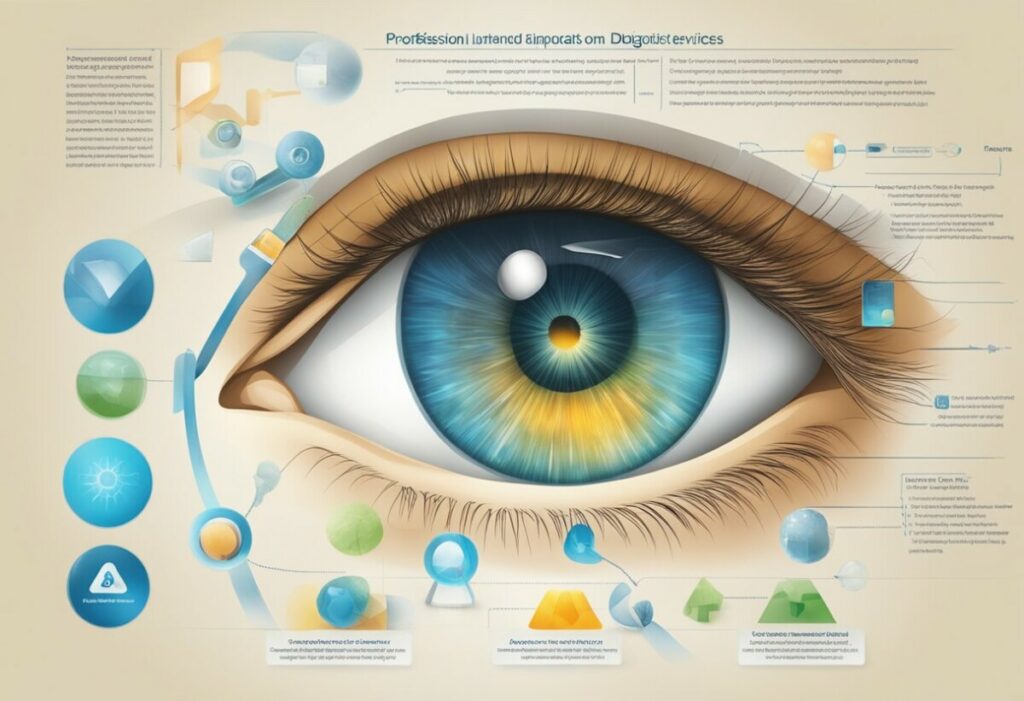Accessing Eye Care: Navigating Resources for the Visually Impaired

As a leader in assistive technology and training for the visually impaired, we at New England Low Vision and Blindness understand the challenges faced when accessing eye care resources. In recognition of March Eye Care Awareness Month, it’s important to highlight the crucial role of comprehensive eye exams and the advanced resources available to those with visual impairments. Vision health is a vital aspect of overall wellness, yet it is often overlooked until significant issues arise. Ensuring that you have access to the necessary tools, support, and information is the first step in maintaining eye health and managing vision loss effectively.
The path to accessing these resources can sometimes be complex, but with the right guidance, it becomes easier. Regular eye exams can help detect issues early, and for those experiencing vision loss, there are a multitude of resources designed to enhance daily life. Identifying these resources, whether technological advances or supportive communities, lays the foundation for empowerment.
In service to our community, we offer leading-edge solutions and dedicated training to foster independence and hope. By utilizing our life-changing tools, individuals with visual impairments can navigate the world more confidently. The resources available not only support everyday tasks but also encourage continued personal and professional growth.
Understanding Visual Impairment
Visual impairment encompasses a variety of conditions that affect one’s ability to see. The spectrum ranges from partial vision—referred to as low vision—to the complete lack of vision, which is known as blindness. Visual acuity and visual field are two critical components used to assess the degree of impairment.
Visual Acuity: This measures the sharpness of vision, often with Snellen’s chart, which evaluates the ability to discern letters or shapes at a specific distance. A reading of 20/20 indicates normal vision, while levels below that may signify an impairment.
Visual Field: This pertains to the entire area that can be seen without moving the eyes or head, encompassing central and peripheral vision. Conditions limiting the visual field include glaucoma, which can lead to vision loss primarily in the peripheral areas.
Several eye conditions can result in visual impairments, such as age-related macular degeneration (AMD), which affects central vision, and glaucoma, characterized by damage to the optic nerve often due to increased pressure in the eye.
We at New England Low Vision and Blindness, as a leading assistive technology provider, empower individuals with visual impairments by offering leading-edge resources and training. March Eye Care Awareness Month serves as a vital reminder of the importance of comprehensive eye exams to detect these conditions early and to secure the necessary interventions to maintain the best possible vision. Our commitment to bringing hope through life-changing resources and training stands firm for all seeking assistance in navigating life with impaired vision.
Diagnostic Services and Professional Care
When it comes to addressing visual impairment, accessing the right diagnostic services and professional care is crucial. Early and accurate assessment by a qualified eye care specialist is the foundation of effective management and treatment.
Ophthalmologists are medical doctors specializing in eye and vision care, including the diagnosis and treatment of eye diseases. They are trained to provide a full spectrum of eye care, from prescribing glasses and contact lenses to performing complex surgeries.
Optometrists, on the other hand, are primary healthcare professionals for the eye. During March Eye Care Awareness Month, we underscore the importance of comprehensive eye exams conducted by optometrists. They play a pivotal role in the early detection of visual issues through thorough assessments and can provide referrals to specialists when advanced care is necessary.
Our commitment at New England Low Vision and Blindness is to ensure that those with visual challenges receive leading-edge assistive technology provider and assistive technology trainer, to enhance their quality of life. We believe in the power of hope and technology to overcome obstacles presented by vision loss. To support this, we assist individuals by connecting them with professional eye care services and guiding them through the process of adapting to their enhanced visual capabilities.
It is vital to remember that regular eye check-ups can significantly improve the quality of life for individuals with visual impairments. Professional care and accurately prescribed visual aids can help in maximizing the remaining vision. We stand with you in advocating for proactive eye health practices and the pursuit of excellent care for all who require it.
Navigating Resources and Support
As we observe March Eye Care Awareness Month, it’s crucial to highlight the importance of accessing appropriate support and resources for those experiencing vision loss. At New England Low Vision and Blindness, we understand that finding reliable assistance can be transformative.
Local and National Organizations: Community-based resources like the American Council of the Blind provide social care and emotional support, crucial for adapting to vision loss. Similarly, the National Federation of the Blind offers extensive support services, fostering independence and confidence.
Educational Materials and Assistive Technology: The American Printing House for the Blind is a valuable source of educational materials and tools. We contribute to these efforts by providing leading-edge assistive technology training to empower those with vision impairments.
Information and Peer Support: Informative platforms like VisionAware act as a comprehensive guide through vision loss, while our team at New England Low Vision and Blindness remains committed to offering hope and assistance with life-changing resources.
Professional Guidance: For accessing specialized resources, the Veterans Administration (VA) can be indispensable for eligible individuals. Additionally, the National Library Service caters to the reading needs of the visually impaired.
Support In Your Journey: Our commitment is to guide you to the right resources, whether that includes finding local support groups or connecting to national organizations. Embodying March’s theme, we emphasize the preventive aspect of eye care, encouraging comprehensive eye exams to maintain ocular health.
Finding and using these resources can significantly aid in navigating life with vision loss. Let us be your partners in this journey, helping you harness the power of community and technology.
Technologies and Aids for Independence
In celebration of March Eye Care Awareness Month, we highlight essential technologies and aids, providing those with visual impairments greater independence in their day-to-day lives. From innovative magnification devices to literacy tools, these resources are pivotal for enhancing the quality of life.
Adaptive Technologies for Daily Living
Living with visual impairment presents unique challenges, but with the right assistive technology, daily tasks become more manageable. Our suite of low-vision devices, such as magnifiers and large print solutions, enables individuals to read medication labels or enjoy the morning paper with ease. For navigating the digital world, software like ZoomText enlarges and enhances screen content, while text-to-speech devices scan and read printed text aloud.
- Magnification: We provide various magnification tools, including handheld and stand magnifiers, to cater to different needs and preferences.
- High-Tech Glasses: For those requiring hands-free options, glasses with built-in magnification and adjustable settings aid in a variety of tasks.
Educational and Literacy Tools
Education and literacy are keystones for empowerment, and assistive technology bridges gaps for those with visual impairments. Braille resources, such as braille displays, support individuals in learning and communicating effectively. For non-braille users, audiobooks and text-to-speech tools ensure access to a vast library of literature and educational materials.
- Braille Tools: We offer braille display devices, and embossers to support both learning and day-to-day communication.
- Literacy Software: Tools like text-to-speech software help in consuming written content, making learning more accessible.
In these efforts, New England Low Vision and Blindness stands as a leading assistive technology provider, offering leading-edge technology and training to enhance independence for people with visual impairment. Our commitment is to bring hope and practical solutions to individuals navigating life with these challenges.
Empowering Children and Families
At New England Low Vision and Blindness, we understand the significance of empowering children with visual impairments, along with their families and caregivers. During March Eye Care Awareness Month, we emphasize the importance of comprehensive eye exams and how they contribute to the management of vision health.
For Parents and Caregivers
- Educational Resources: Access to leading-edge educational tools is crucial.
- Support Networks: Platforms like FamilyConnect offer invaluable connection opportunities.
- Advocacy: Knowledge empowers you to advocate effectively for children’s needs.
For Children
- Technology: Tailored assistive technology fosters independence.
- Literacy: Encouraging literacy through accessible formats is a key to learning.
- Confidence: With the right tools and support, children can achieve their full potential.
We offer assistance by:
- Providing resources that promote eye health.
- Training families to use assistive technology effectively.
- Connecting them with organizations for additional support.
We pride ourselves on being a leading provider of assistive technology services. We believe every child and family can benefit from our life-changing resources. Together, we can build a foundation for a proactive approach to eye care and visual assistance.
Community Involvement and Advocacy
In our commitment to eye care, we recognize the power of community involvement and the vital role of advocacy groups. Engaging communities provides a platform for collective action and mutual support among those with visual impairments.
Outreach initiatives are essential in imparting knowledge about vision health and eye care resources. During March, our focus intensifies to spread awareness about the significance of comprehensive eye exams. We partner with organizations that work tirelessly to ensure that individuals are informed and proactive about their vision.
VisionAware and the American Council of the Blind empower individuals through outreach programs that foster education and self-advocacy. These entities work hand-in-hand to serve as a beacon, leading to improved access to eye care services.
Support groups play a crucial role, offering assistance and camaraderie to those adapting to life with low vision. These groups are foundations of encouragement, where experiences are shared, and adaptive strategies are learned.
NFB-Newsline offers independent access to information through a variety of newspapers and magazines for the blind and visually impaired community, an empowering tool for those seeking to stay informed.
We remain devoted to providing leading-edge assistive technology and training to enhance the capabilities of individuals with visual impairments. By offering life-changing resources, we bring hope and drive progress in eye care awareness and advocacy.
To further our cause, we advocate for comprehensive policies that improve the lives of the visually impaired, ensuring our unified voice is heard where it matters most. Empowerment comes through unity, and in unity, we find the strength to advance and safeguard the well-being of our community.





